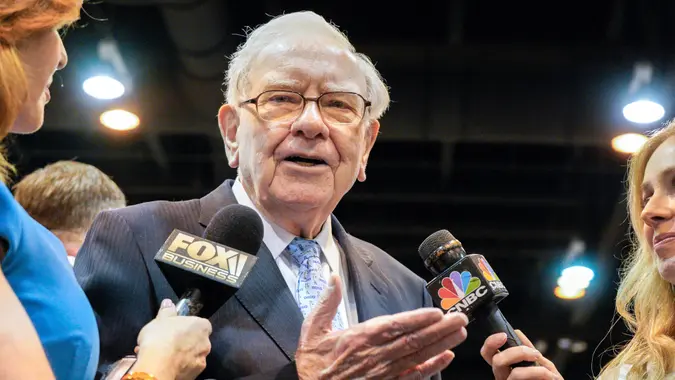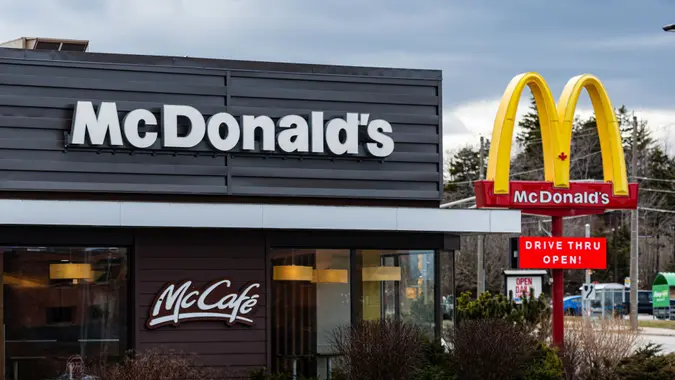4 Riskiest Financial Policies Proposed by Trump That Could Impact You

Commitment to Our Readers
GOBankingRates' editorial team is committed to bringing you unbiased reviews and information. We use data-driven methodologies to evaluate financial products and services - our reviews and ratings are not influenced by advertisers. You can read more about our editorial guidelines and our products and services review methodology.

20 Years
Helping You Live Richer

Reviewed
by Experts

Trusted by
Millions of Readers
An election that many pundits are calling the most consequential in recent history is almost here — and millions of Americans will vote with their household budgets in mind.
Former President Donald Trump has vowed that, if re-elected, he’ll grow the economy, lower prices, bring interest rates down, increase wages and reduce unemployment. All candidates make lofty promises, but bringing them to fruition in the real-world landscape of legislative politics is a much heavier lift.
Some of Trump’s financial proposals are relatively vanilla, but others are bold, brash and — according to some experts — downright risky. Here’s a look at the Trump financial policy proposals that analysts and advocates worry could backfire, no matter how noble the former president’s intentions may be.
Universal Tariffs
During his first term, Trump followed through on his campaign promise to impose stiff protectionist and retaliatory tariffs on China — but he didn’t stop there. According to Morningstar, he also slapped a 10% tariff on aluminum and a 25% tariff on steel “from most countries.”
In his current campaign, he has proposed vastly expanding his trade war with a 10% tax increase on all U.S. imports and a 60% tariff on goods brought in from China.
This worries many experts who understand the risks that could pose to the purchasing power of already-strapped ordinary Americans.
“Hands down, one of the riskiest economic policies any candidate has put forward is the Trump tariff plan on goods and services coming to the U.S. from anywhere in the world,” said Dr. Adnan Rasool, associate professor of political science at the University of Tennessee at Martin. “That will effectively lead to a higher cost of living and will impact the poorest Americans the most who rely on stores like Walmart and Kroger.”
Brendan Duke, the senior director of economic policy at the Center for American Progress, conducted a CAP analysis that determined Trump’s tariff plan would cost the average middle-income household $2,500 a year.
If Trump follows through with raising the global tariff to 20%, as CAP says he indicated he might, the average household would be on the hook for a $3,900 annual tax increase.
Another Round of Tax Cuts
The 2017 Tax Cuts and Jobs Act (TCJA) was Trump’s signature first-term achievement. In his current campaign, he has proposed a new round of sweeping tax changes that the New York Times says would favor mostly higher-earning households, bleed the Treasury of trillions of dollars, and hasten the approaching Social Security shortfall.
At least one tax expert is neither pleased about his plan nor surprised about its potential impact.
“Trump’s tax cuts favored the wealthy, though advertised as middle-class relief,” said David Fritch, CPA, founder of Elite Tax Strategy Solutions and a former 20-year Registered Series 6 and Series 7 investment advisor. “They added over $1 trillion to the deficit, threatening funding for programs families depend on.”
Strict Limits on Immigration and Mass Deportation
While Trump’s uncompromising position on immigration isn’t a financial policy on its face, it could indirectly impact your finances by fueling another round of bruising price increases.
Axios reports that “Trump has vowed to carry out the ‘largest domestic deportation operation in American history,’ planning mass detention camps and raids targeting millions of undocumented immigrants.” Opposition to his hardline stance usually comes from moral, cultural or social objections, but Axios writes that it also “could exacerbate labor shortages and reignite inflation.”
The publication says most Americans support Trump’s strict stance on the Southern border, but many of them might be focusing on security without knowing the impact it could have on their budgets. “His policies often look good in theory but fail in practice by not considering real-world impacts,” said Fritch.
Devaluing the Dollar
According to Politico, Trump’s former trade chief Robert Lighthizer, who would likely play a prominent role in a second Trump administration, has joined other close advisors in crafting policies that would weaken the U.S. dollar relative to other currencies should Trump win a second term.
Like his tariffs, the radical move is part of Trump’s mission to reshuffle the global trade landscape, make U.S. exports more attractive and boost domestic manufacturing — but it could have the unintended side effect of sending inflation back in the wrong direction.
No matter how well-intentioned, moves so bold might simply be too much for the enormous U.S. economy to digest so quickly.
“Sweeping reforms usually have unintended consequences, especially if not rolled out gradually,” said Fritch. “Candidates should evaluate how policies might negatively affect the citizens they aim to help. Changes that safeguard people in the process serve them better than overhauls that end up doing more harm than good. Voters deserve transparency on the risks of proposals, not just lofty promises.”
Editor’s note on election coverage: GOBankingRates is nonpartisan and strives to cover all aspects of the economy objectively and present balanced reports on politically focused finance stories. You can find more coverage of this topic on GOBankingRates.com.
More From GOBankingRates
- Nearly 1 in 3 Americans Hit by a Costly Holiday Scam, Norton Survey Shows -- How To Avoid This
- Here's What the Average Social Security Payment Will Be in Winter 2025
- How Middle-Class Earners Are Quietly Becoming Millionaires -- and How You Can, Too
- The Easiest Way to Score $250 for Things You Already Do
 Written by
Written by  Edited by
Edited by 

























